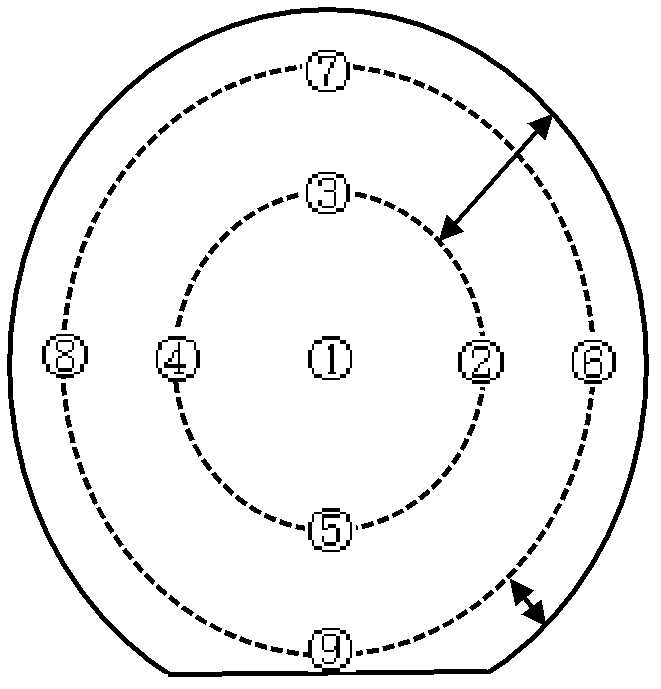Epitaxial wafer substrate capable of reducing auto-doping during epitaxy, epitaxial wafer and semiconductor device
An epitaxial wafer and self-doping technology, which is applied to semiconductor devices, semiconductor/solid-state device components, electric solid-state devices, etc. It can improve the uniformity of resistivity, improve the uniformity of resistance, and reduce the production cost.
- Summary
- Abstract
- Description
- Claims
- Application Information
AI Technical Summary
Problems solved by technology
Method used
Image
Examples
Embodiment 1-4
[0036] figure 2 It is a schematic diagram of the structure of the epitaxial wafer substrate that can reduce self-doping during epitaxy in Embodiment 1-4. Such as figure 2 As shown, the epitaxial wafer substrate that can reduce self-doping during epitaxy includes a substrate body 1 , and a silicon dioxide layer 4 is provided on the back of the substrate body 1 . The substrate body 1 can be N-type, that is, doped with arsenic, phosphorus or antimony; the substrate body 1 can also be P-type, that is, doped with boron.
[0037] The silicon dioxide layer on the back side of the substrate body can use the APCVD (atmospheric pressure chemical vapor deposition) method to complete the silicon dioxide layer of the back-sealing structure of the substrate.
[0038] Chemical reaction equation: SiH 4 +2O 2 → SiO 2 +2H 2 o
[0039] Silica uses the WJ machine, which uses a low-temperature process, the reactor structure is relatively simple, and the deposition rate is fast. In the se...
Embodiment 5-8
[0042] image 3 It is a schematic diagram of the epitaxial wafer structure in Embodiment 5-8. Examples 5-8 used the substrates in Examples 1-4, respectively. Such as image 3 shown, epitaxial wafers, including figure 2 In the shown substrate, an epitaxial layer 3 is grown on the front surface of the substrate body 1 . The substrate includes a substrate body 1 , and a layer of silicon dioxide film 4 is arranged on the back of the substrate body 1 . The epitaxial layer 3 is arranged on the front surface of the substrate body 1 .
[0043] In Comparative Examples 1-4, no silicon dioxide layer is provided on the backside of the heavily arsenic-doped substrate body, and the epitaxial layer is directly grown on the front side of the substrate body.
[0044] The comparative data of the epitaxial layer resistance uniformity of Examples 5-8 and Comparative Examples 1-4 are shown in Table 1-4. In each group of comparisons, two substrate bodies produced in the same batch were selec...
Embodiment 9-12
[0056] Figure 4 It is a schematic diagram of the structure of an epitaxial wafer substrate that can reduce self-doping during epitaxy in Examples 9-12. Such as Figure 4 As shown, the epitaxial wafer substrate that can reduce self-doping during epitaxy includes a substrate body 1 , and a layer of silicon dioxide film 4 is provided on the back of the substrate body 1 . The substrate body 1 has a monocrystalline silicon layer 2 on the front side. The thickness of the single crystal silicon layer 2 is 2-5 μm. Its specific thickness can be determined according to the overall thickness of the epitaxial wafer and the thickness of the substrate body. The higher the substrate thickness, the thicker the monocrystalline silicon layer. In subsequent production, an epitaxial layer is grown on the surface of the single crystal silicon layer 2 .
[0057] The substrate body 1 can be N-type, that is, doped with arsenic, phosphorus or antimony; the substrate body 1 can also be P-type, th...
PUM
| Property | Measurement | Unit |
|---|---|---|
| thickness | aaaaa | aaaaa |
Abstract
Description
Claims
Application Information
 Login to View More
Login to View More - R&D
- Intellectual Property
- Life Sciences
- Materials
- Tech Scout
- Unparalleled Data Quality
- Higher Quality Content
- 60% Fewer Hallucinations
Browse by: Latest US Patents, China's latest patents, Technical Efficacy Thesaurus, Application Domain, Technology Topic, Popular Technical Reports.
© 2025 PatSnap. All rights reserved.Legal|Privacy policy|Modern Slavery Act Transparency Statement|Sitemap|About US| Contact US: help@patsnap.com



